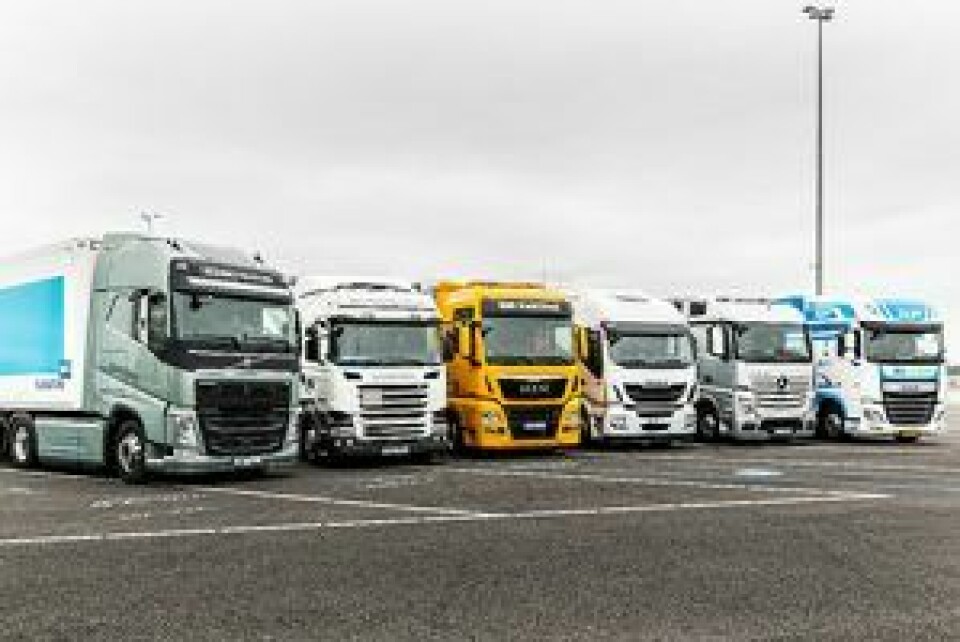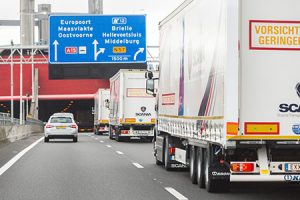Truck platooning: a future benefit for automotive logistics
A recent test of truck platooning has successfully demonstrated the technology’s considerable potential for commercial vehicle fleets...
In the first half of 2016, the Netherlands held the presidency of the council of the European Union and during this time, Melanie Schultz van Haegen, minister of infrastructure and environment (which transport falls under), chose to put automated and connected driving higher on the agenda.
Van Haegen was key in organising the signing of the Amsterdam Declaration, in which all 28 transport ministers of the EU jointly agreed to accelerate the legislation relating to automated and connected driving and to stimulate its development. “This is quite a move forward,” commented Maurice Geraets, board member and head of new business at NXP Semiconductors, about the development.
But the Amsterdam Declaration is just a memorandum of understanding and doesn’t guarantee anything, which is how the truck platooning challenge came about.
Van Haegen invited the Europe’s six largest truck manufacturers – Scania, Volvo, Daimler, Iveco, MAN and DAF – to compete in the challenge. All six companies had their own trucks driving from their own locations to Rotterdam. On April 6th, all the platoons arrived safely in Rotterdam. Each OEM had two or three trucks in their individual platoons, the first with a regular driver in it and the others manned but following automatically.
While some higher-end passenger cars now have adaptive cruise control that can follow a vehicle in front at a distance of 50-70 metres, truck platooning is based on a much shorter distance between vehicles – typically 8-10 metres – to take advantage of the potential fuel savings and increase safety.

Volvo, Scania, MAN, Iveco, Mercedes-Benz and DAF all successfully ran vehicle platoons to Rotterdam in the April trial
Benefitting from the slipstream of the vehicle in front, trucks following in such a platoon consume 15-20% less fuel. And thanks to lower air drag at the rear, even the first truck reduces its fuel usage by 5-10%.
“You gain enormous fuel efficiency and by saving fuel you’re also saving emissions,” Geraets said. That means the cost of the truck usage goes down while damage to the environment also decreases. “With that, there is a strong case for the drivers, truck owners, and for the governments to push this forward,” Geraets said.
NXP supplied its technology to most of the six truck OEMs involved in the challenge and has worked considerably with DAF, in particular, to make the platooning challenge happen.
“As the trucks are so close, you cannot just rely on radar and cameras – you have to add something to it,” said Geraets. “What you add is a direct wireless connection between the trucks so the second and third trucks, at a few milliseconds’ delay, will follow the acceleration and braking pattern of the first truck. As soon as it’s accelerating or braking, the second truck will receive the information wirelessly and change speed, based on the signal.”
Geraets said the direct wireless connection, which is standardised in Europe and the US and on a band reserved specifically for this purpose, is an open standard. And based on this wireless communication, following trucks can respond to a change by the vehicle in front around 20 times faster than a normal driver.
“Because of the ultra-fast communication, you ensure that the second truck can react 20 times faster than a normal driver. For that reason, we can close the distance [between vehicles] to much less, which has the benefit of improving fuel efficiency and improving safety. More than 90% of accidents in the world occurring in traffic are caused by human error. You are much safer relying on the technology than you are on drivers,” said Geraets.
Automotive Logistics decided to ask Geraets more about just how this technology works and what the real benefits will be…
Automotive Logistics: What happens if a car moves in between the trucks?Maurice Geraets: “When a car gets in between – which shouldn’t generally happen as a passenger car driver would consider that distance quite narrow – the trucks will know something is happening because of a range of sensors, cameras, and V2V communication etc. The second truck will increase the distance autonomously so there is a safe distance to the passenger car. Once the passenger car takes an exit off the highway or moves lanes, the second truck can move back up again.”
AL: Are there any concerns over security and hacking?MG: “This is something we have to make sure we do. With the hacking aspect, we address that by also having NXP security chips in the trucks. That means with the wireless communication between the trucks, they are constantly communicating. Every message sent by the first truck will be digitally signed, so the second truck gets the content of the message along with a signature. That signature will show if the sender is trustworthy and whether the message is really coming from the truck or from elsewhere. The second truck will only act on the instructions of the message if it can be verified that it is from the first truck. Any messages trying to disrupt the platooning will be ignored by the second truck. In that way, you can ensure that hackers cannot beat the system by sending messages.
“Regarding the security of the vehicle’s electronics, that is applicable to any connected vehicle in the world and also something that we’re focusing on as part of the consortium. One aspect is the security and hacking, and the other is robustness. The technology should be so robust and work so well that you can completely rely on it. As you can imagine, you are putting the life of the second driver into the hands of the first. It’s not just a consumer electronic chip that you put in a television or something. It’s really automotive-grade quality that you know will work. When you press the brakes in a car, you always know that it’s going to stop. All the technology that supports platooning is reliable in such a way that guarantees safety.”
AL: What further developments are needed for this technology to be successfully implemented?MG: “A lot of it has to do with legislation. With the truck platooning challenge back in April, all the countries involved had to give explicit exceptions to the drivers to allow this to happen. In Belgium, France and Germany you have laws that determine the distance between cars on the road. In Germany, the law says any driver should be two seconds’ distance between vehicles. In France and Belgium, they say 50 metres. In the Netherlands, the law says you should have a ‘safe’ distance. This is a good description! If we can prove the platooning technology is safe at 5-10 metres between trucks, then all these countries have agreed to change their laws to make this happen. Belgium is prepared to change the law from 50 metres to ‘safe distance’, but it hasn’t been passed yet. We expect in many European countries, many will have law changes in the coming years so you can expect that from 2020 onwards, truck platooning will happen on the roads. In line with what the truck OEMs state, the expectation is 2020.”
AL: Could logistics companies benefit from truck platooning?MG: “If you look to logistics companies, they would need multiple trucks going in the same direction. In practice, that isn’t so difficult. In the Netherlands, for example, a large trucking company states that on the A2 – the north-south connection road – every five minutes, seven trucks from that company drive in the same direction. That wouldn’t be too difficult to agree and do platooning with. The issues will be more on the legislation side than about OEMs having to change. That was also proved on the April 6th event, when all six companies proved it could be done reliably and safely.”
 It is unlikely other vehicles will regard the gap between trucks in a platoon as a space to move into, but if they do, following trucks will simply fall back to maintain a safe distance
It is unlikely other vehicles will regard the gap between trucks in a platoon as a space to move into, but if they do, following trucks will simply fall back to maintain a safe distanceAL: Will the technology be expensive to implement?MG: “It will not be that expensive. There are development costs but OEMs are working on it. A lot of the technology is also available already – such as radars or cameras – to increase the safety of truck driving. If you add the communication module – that will allow the two trucks to platoon – that will definitely not be a large added cost. You could compare it with having to add eCall to all passenger cars in Europe from April 1st 2018 – that hasn’t added a lot of cost either. Especially when you compare that cost to the 10% that is achievable through fuel savings, less wear-and-tear, etc. Cost-wise, this will not add anything significant.”
AL: How would the platooning technology be dealt with by insurance companies?MG: “This is something that is still being worked out. There will be a shift of responsibility from the driver to the vehicle producer. If I, as a truck driver, make a mistake then I am responsible as a driver and insurance will govern my responsibility. If you look to the second truck technically making a mistake – which is unlikely – the truck manufacturer would have a higher probability of having to deal with the case.”
AL: Do the trucks have to be closed, or could the technology be used on car transporters, for example?MG: “If you look at the truck platooning challenge, OEMs used their own trucks. Communication between trucks is pretty much standardised, however, for more advanced structures, there needs to be more standardisation. The hardware side is pretty much there, but on the software side, there’s still some ongoing standardisation. That will be happening in the next two to three years, and will be ready for 2020. “If you are the second truck, it can be boring, but we’ve tried to change that. So instead of seeing the back of the lorry ahead, the second truck has a large screen which displays the video from a dashboard camera of the lead truck. It transmits signals to the second truck. That helps the second driver to react, helps them to be more alert, and helps psychologically.”
AL: Can platooning trucks help solve issues with driver shortages?MG: “In the long term, yes, definitely – but looking to the next ten years, you will still need to have alert drivers in the second truck. The driver will still be present in the second truck but on the highway, he could sleep or do other work. However, reaching a stage where there’s no driver in the second truck is quite a few years away. “In closed areas that might be different. In a port, for example, you can already see fully autonomous vehicles. In enclosed areas with no pedestrians and where it is safe, you could solve some issues with driver shortages.”
AL: Is there any other technology in the works that could help the automotive logistics industry?MG: “Speed docking is one example. If a truck arrives at its destination, it will automatically connect to the docking system, releasing the driver from that task and making it a bit easier. It prevents accidents and damage to the truck and anything on the truck. “In closed areas, such as ports, there are already automatic logistics systems in place. When container ships are unloaded, AGVs [automated guided vehicles] drive to the location where the cargo will be offloaded. Then you can combine with the speed docking and the container can be loaded onto the truck. There is quite a high level of automation already happening in logistics.”






